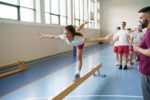Laptops, tablets, and apps are just some of the latest tech tools that teachers are using to spark students’ interest in STEM disciplines, which include science, technology, engineering, and math. Other trends include moving away from traditional face-to-face instruction and toward more hybrid learning opportunities, including online instruction and hands-on projects. Instructional videos and coaching courses have become instrumental elements within education and the overall development of today’s youth. All of these new technologies and approaches will produce stronger fundamentals and increase interests within STEM education.
The National Assessment of Educational Progress (NAEP), known as The Nation’s Report Card, is “the largest nationally representative and continuing assessment of what America’s students know and can do in various subject areas,” including STEM. Over the past year, the National Assessment Governing Board and the National Center for Education Statistics have released three reports on 2015 NAEP data—covering student achievement in science, technology and engineering literacy, and math.
Education experts Cary Sneider and Mary Crovo discussed with us the issues at the heart of these NAEP reports. Sneider is a member of the National Assessment Governing Board and an associate research professor at Portland State University. He is also a consultant for STEM Next, University of San Diego, and chair of the LinkEngineering committee for the National Academy of Engineering. As Deputy Executive Director of the Governing Board, Crovo brings a unique perspective and deep understanding of the data in all three reports.
Can you tell parents why STEM awareness and education are so important for students?
Dr. Sneider: “Just about every job requires some STEM capabilities. For example, I can’t think of a job that doesn’t require an employee to use computers in some way or another. Not just computers, but being able to solve problems and being able to perceive a situation, define the problem that needs to be solved and using a systematic process to solve that problem. The ability to communicate with others and the ability to do mathematics are all necessary for the modern world that we live in. It’s not just for getting jobs, it’s also for living everyday life. We all negotiate apartments, houses, and transportation. All of these issues require us to make important technological decisions every day. So it’s really essentially that our kids today learn about the STEM field so that they can be responsible workers, citizens, and consumers in tomorrow’s society.”
Dr. Crovo: “It’s never too early to start. Even in pre-K and kindergarten students, particularly young girls and students of color. Technology isn’t something that’s only for high school-aged students, it can start very early and it’s important to do so.”
What influence does technology have in learning STEM subjects?
Dr. Sneider: “I’ve been in a lot of classes and in every one of those classes, teachers are using PowerPoints to present many ideas. Many of the kids have their cell phones underneath their desk while they’re texting their friends. That can be distracting, but teachers [who] are aware of technology have their students bring their cell phones and put it on their desk. They ask that they download some free apps. For example, you can download an app that allows students to analyze sound. The world has changed as a result of the informational technologies that we have.”
Dr. Crovo: “It’s important to have a very broad sense of what technology is in our everyday world. It’s certainly digital computer-based technology, but it’s technology related to construction, medicine, transportation, and so many other fields that students need if they’re going to be able to navigate this world’s complex society.”
Do you have any advice for parents and teachers on how they can encourage students to pursue STEM classes and careers in the future? Also, do you have any recommendations on where people can get more information?
Dr. Sneider: “This year, we’ve had three major releases from national assessments. We have found strong correlations with the success [of] these assessments and hands-on activities in schools. We have also found strong correlations with after-school experiences and extracurricular class experiences. The message is that if teachers really engage their students in interesting activities that are rigorous, enjoyable, and interesting, then students are going to do better in these subjects. Also, parents can look for things for students to do during the summer, after school or right at home.”
Dr. Crovo: “Parents can look around their own community and their family, maybe it’s an engineer, welder, or nurse—there are a lot of STEM resources that many people don’t realize.”
What is the one question you often get from parents and/or teachers, no matter what the platform is?
Dr. Sneider: “How can we help our kids? My answer is simple. Be encouraging, even when they come home from school in tears because they had a hard time with math and science. Parents must relay to their children that we all have a hard time and this struggle is part of it, and they’ll get through it. Be persistent and let them know that they’ll do well. And express to them that they’ll be stronger when they overcome these hurdles.”






















































































































